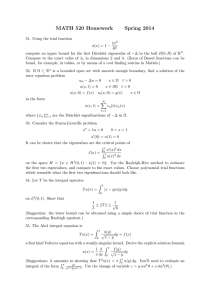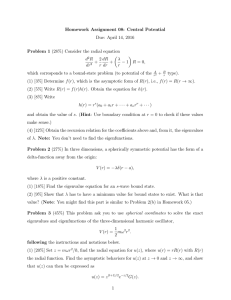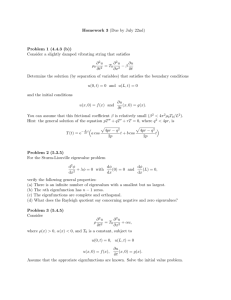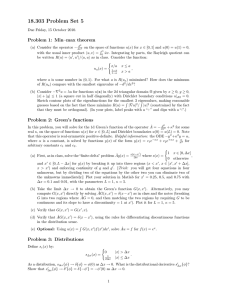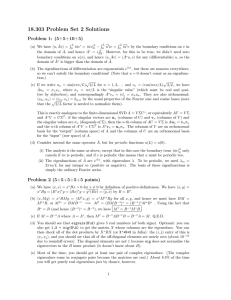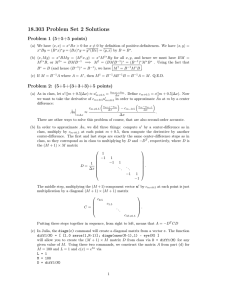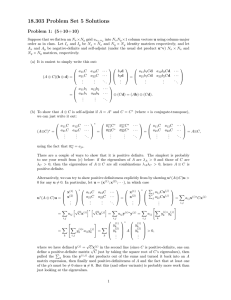18.303 Final Topic Summary December 13, 2010
advertisement
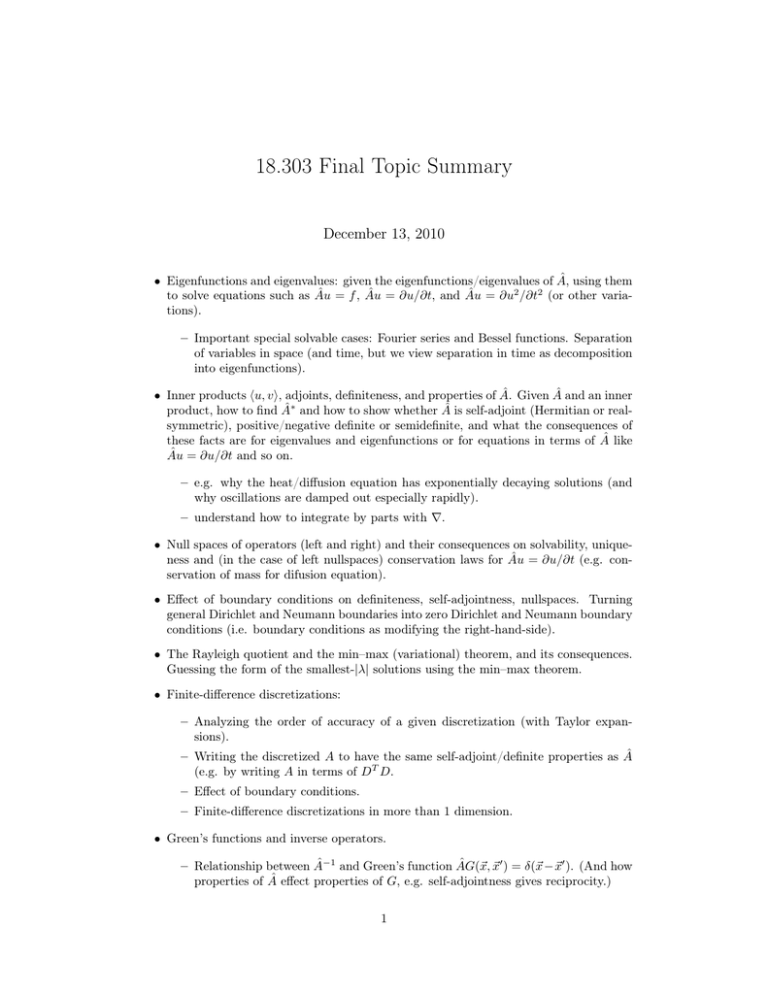
18.303 Final Topic Summary December 13, 2010 • Eigenfunctions and eigenvalues: given the eigenfunctions/eigenvalues of Â, using them to solve equations such as Âu = f , Âu = ∂u/∂t, and Âu = ∂u2 /∂t2 (or other variations). – Important special solvable cases: Fourier series and Bessel functions. Separation of variables in space (and time, but we view separation in time as decomposition into eigenfunctions). • Inner products hu, vi, adjoints, definiteness, and properties of Â. Given  and an inner product, how to find Â∗ and how to show whether  is self-adjoint (Hermitian or realsymmetric), positive/negative definite or semidefinite, and what the consequences of these facts are for eigenvalues and eigenfunctions or for equations in terms of  like Âu = ∂u/∂t and so on. – e.g. why the heat/diffusion equation has exponentially decaying solutions (and why oscillations are damped out especially rapidly). – understand how to integrate by parts with ∇. • Null spaces of operators (left and right) and their consequences on solvability, uniqueness and (in the case of left nullspaces) conservation laws for Âu = ∂u/∂t (e.g. conservation of mass for difusion equation). • Effect of boundary conditions on definiteness, self-adjointness, nullspaces. Turning general Dirichlet and Neumann boundaries into zero Dirichlet and Neumann boundary conditions (i.e. boundary conditions as modifying the right-hand-side). • The Rayleigh quotient and the min–max (variational) theorem, and its consequences. Guessing the form of the smallest-|λ| solutions using the min–max theorem. • Finite-difference discretizations: – Analyzing the order of accuracy of a given discretization (with Taylor expansions). – Writing the discretized A to have the same self-adjoint/definite properties as  (e.g. by writing A in terms of DT D. – Effect of boundary conditions. – Finite-difference discretizations in more than 1 dimension. • Green’s functions and inverse operators. – Relationship between Â−1 and Green’s function ÂG(~x, ~x0 ) = δ(~x −~x0 ). (And how properties of  effect properties of G, e.g. self-adjointness gives reciprocity.) 1 – Solving G in simple cases (using the delta function, not using ugly limits), especially empty space Ω = Rd . – How solutions Â−1 f are made from the Green’s function. – How the Green’s function G0 of empty space relates to Green’s functions in inhomogeneous systems or systems with boundaries. Born–Dyson series and Born approximations. • Delta functions and distributions. – Definition, regular vs. singular distributions. Differences from ordinary functions. – Distributional derivatives. – Solving PDEs with δ on the right-hand side (e.g. finding Green’s functions, above). • Time-stepping and stability. – Convergence, consistency, stability (conditional and unconditional). Implicit vs. explicit schemes. – Von Neumann analysis. (e.g. forward, backward, and centered differences, Crank-Nicolson, and leap-frog schemes.) • Wave equations 2 – Âu = ∂∂t2u vs. D̂w ~ = ∂∂tw~ formulations. (e.g.  = ∇2 vs. w ~ = [u; ~v ] forms of scalar wave equations). – Conservation of energy from D̂ = D̂∗ , correct choice of inner product hw, ~ w ~ 0 i. ~ – D’Alembert’s solution f (x − ct) + g(x + ct). Planewave solutions ei(k·~x−ωt) . – Staggered-grid and leap-frog discretizations, and other discretizations; stability √ and the CFL condition c∆t ≤ ∆x/ #dimensions. – Wave velocity: group velocity ∂ω/∂k and phase velocity ω/k. Fourier-transform picture (from class) and energy-transport picture (from homework). ∗ Wave dispersion (ω-dependent velocity): numerical, material, and geometric. – Waveguides: ∗ Separable eigenfunctions uk ei(kz−ωt) , the reduced eigenproblem Âk or D̂k , and the dispersion relation ω(k). ∗ Hard-wall waveguides (e.g. a hollow pipe with Dirichlet or Neumann boundaries), and the corresponding ω(k) dispersion relation. ∗ Snell’s law, total internal reflection evanescent waves, and “slow-light” waveguides from low-c regions. The light cone and dispersion relations. – The frequency-domain problem: a source ∼ e−iωt and the resulting steady-state solution ∼ e−iωt . ∗ Scalar waves: the Helmholtz equation (∇2 + ω 2 )u = f . The corresponding Green’s function ∼ eiωr/c /r in 3d, ∼ eiω|x| in 1d, etcetera. 2

